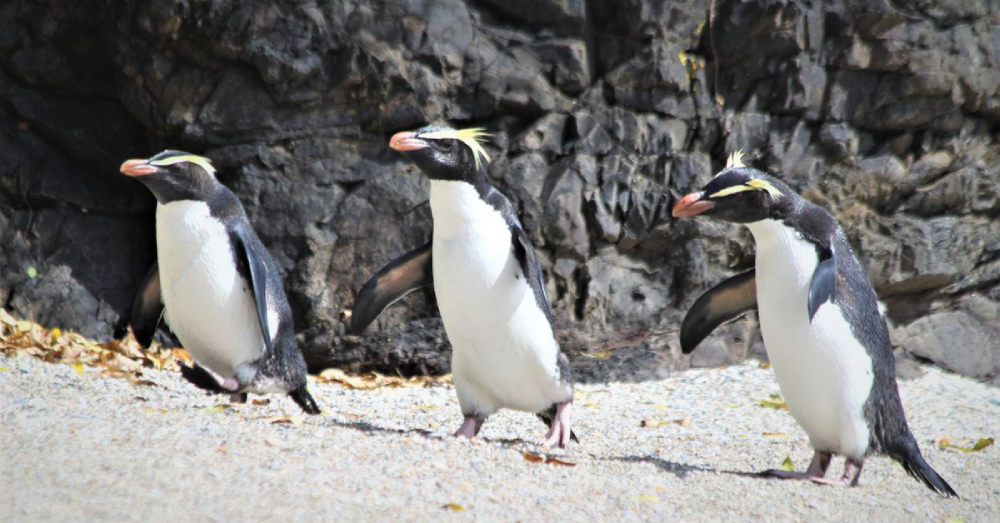In the remote and rugged landscapes of New Zealand’s Fiordland, where sheer cliffs plunge into deep fjords, and dense rainforests cloak the land, dwells a creature both enigmatic and captivating—the Tawaki Penguin. Known for its distinctive yellow crest, the Tawaki Penguin, also called the Fiordland Crested Penguin or the “punk rocker” of the penguin world, is a species shrouded in mystery and resilience. In this article, we embark on a journey into the world of the Tawaki Penguin, exploring its habitat, behavior, conservation status, and the challenges it faces in a rapidly changing world.
Habitat and Distribution
The Tawaki Penguin, scientifically classified as *Eudyptes pachyrhynchus*, is one of the rarest penguin species in the world. Its habitat is confined to the remote and inaccessible coastline of Fiordland and some nearby islands on the southwestern coast of New Zealand’s South Island. Unlike many of its penguin counterparts, which prefer ice and snow, the Tawaki Penguin thrives in the temperate rainforests and rocky coastlines characteristic of the region. Here, among the moss-covered rocks and dense foliage, these penguins carve out their nests and forage in the nutrient-rich waters of the Tasman Sea.
Physical Characteristics
Standing at around 50 to 70 centimeters tall and weighing between 3 to 6 kilograms, the Tawaki Penguin is relatively small compared to other penguin species. What sets it apart, however, is its striking appearance. Sporting a distinctive bright yellow crest that extends from its forehead to the back of its head, the Tawaki Penguin earns its reputation as the “punk rocker” of the penguin world. This vibrant plumage serves as a form of identification and plays a crucial role in courtship displays during the breeding season.

Behavior and Reproduction
The breeding season for Tawaki Penguins typically begins in July, during the austral winter. Unlike some penguin species that breed in large colonies, Tawaki Penguins are solitary nesters, often choosing remote and secluded spots along the coastline or within the dense forest undergrowth. They construct their nests using twigs, leaves, and other materials gathered from their surroundings.
Once the nest is ready, pairs of Tawaki Penguins engage in elaborate courtship rituals, which involve vocalizations, head-bobbing displays, and the presentation of pebbles as tokens of affection. After mating, the female lays two eggs, though only one chick usually survives to fledging. Both parents take turns incubating the eggs and caring for the chicks, regurgitating food to feed their offspring until they are old enough to forage on their own.
Foraging and Diet
Tawaki Penguins are expert divers, capable of diving to depths of up to 100 meters in search of food. Their diet primarily consists of small fish, crustaceans, and squid, which they catch using their streamlined bodies and flipper-like wings to propel themselves through the water. The nutrient-rich waters of the Tasman Sea provide ample sustenance for these seabirds, allowing them to thrive in their unique coastal environment.
Conservation Status and Threats
Despite their remote habitat, Tawaki Penguins face a myriad of threats to their survival. Habitat destruction, caused by logging, mining, and other human activities, poses a significant risk to these birds, especially as their forested nesting sites become increasingly fragmented. Climate change also presents challenges, altering ocean currents and temperatures, which can impact the availability of food for Tawaki Penguins and other marine species.
Human disturbance, in the form of tourism, fishing, and pollution, further exacerbates the plight of these vulnerable birds. Increased boat traffic along the coast can disrupt nesting colonies, while accidental bycatch in fishing nets poses a direct threat to their populations. Oil spills and plastic pollution also pose hazards to Tawaki Penguins, affecting both their health and the health of their marine environment.
Conservation Efforts
Efforts to conserve the Tawaki Penguin are underway, led by organizations such as the Department of Conservation (DOC) in New Zealand and various conservation groups. These efforts include monitoring populations, protecting nesting sites, and raising awareness about the importance of preserving the unique ecosystems of Fiordland. Researchers are also studying the behavior and ecology of Tawaki Penguins to better understand their needs and inform conservation strategies.
Conclusion
In the remote wilderness of Fiordland, amidst towering cliffs and ancient forests, the perseveres as a symbol of resilience and adaptability. With its striking appearance, fascinating behaviors, and precarious existence, this enigmatic seabird serves as a reminder of the delicate balance between human activities and the natural world. As we strive to protect the habitats of the Tawaki Penguin and other endangered species, we also safeguard the rich biodiversity and irreplaceable wonders of our planet’s wild places.









